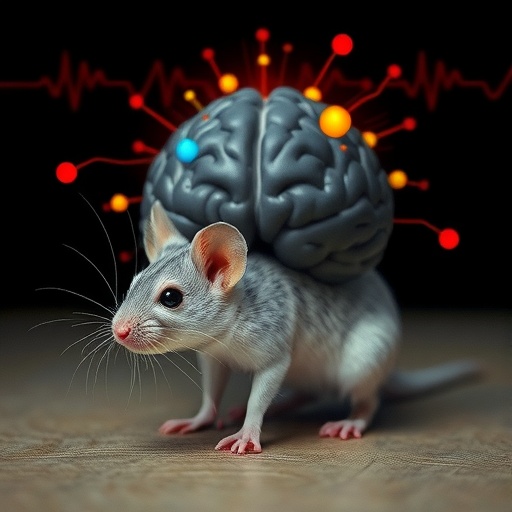In a groundbreaking study published in Biology of Sex Differences, researchers Ugnė Jasinskyte and Ričardas Guzulaitis investigate the complex interplay between brain rhythms and schizophrenia using a novel pharmacological model. Schizophrenia, a severe mental disorder impacting millions worldwide, is characterized by a range of symptoms including hallucinations, delusions, and cognitive impairments. Understanding the underlying mechanisms of this disorder is critical for developing effective treatments, and this research seeks to shed light on how brain rhythms may contribute to the condition.
The study meticulously examines the differences in brain activity patterns between male and female mice, aiming to unravel the nuances of schizophrenia’s effects across genders. Historically, much of the research in neuroscience has focused predominantly on male subjects, often neglecting the potential variations in response that may occur in females. Jasinskyte and Guzulaitis’ work highlights the importance of considering sex as a biological variable in psychiatric research, an approach that is gaining momentum in the scientific community.
Using a state-of-the-art pharmacological model, the researchers induced symptoms that mimic schizophrenia in both male and female mice. The methodology involved administering specific compounds known to disrupt typical neurochemical pathways, leading to alterations in behavior and brain function. This model serves as a fertile ground for understanding how schizophrenia manifests at the cellular and systemic levels, providing critical insight into its neurobiological foundations.
One key aspect of the study is the assessment of brain oscillations, which are vital to various cognitive processes, including perception, attention, and memory. The researchers utilized advanced electrophysiological techniques to record brain rhythms in real-time. The results reveal marked differences in oscillatory patterns between control and treated mice, indicating that the disruption of these rhythms could be a significant indicator of schizophrenia-like symptoms. This discovery could pave the way for new diagnostic markers and therapeutic targets.
Furthermore, the authors delve into the gender-specific responses observed in their model. Female mice displayed a distinct profile of brain rhythm disruptions compared to their male counterparts. Such findings might suggest that the underlying neurobiology of schizophrenia could differ notably between sexes, which has profound implications for personalized treatment strategies. The study underscores the necessity of tailoring interventions based on sex, which could enhance the efficacy of treatments for schizophrenia.
In addition to behavioral assessments, the researchers conducted a battery of biochemical analyses to explore changes in neurotransmitter levels associated with disrupted brain rhythms. Their findings indicated an imbalance in key neurotransmitters such as dopamine and glutamate, both of which play crucial roles in the pathophysiology of schizophrenia. These alterations in neurochemistry further elucidate the mechanisms by which disrupted brain rhythms could lead to cognitive dysfunction and psychiatric symptoms.
The relevance of this research extends beyond the confines of the laboratory; it has significant implications for clinical practice. As mental health professionals strive to develop more effective interventions for schizophrenia, understanding the role of brain rhythms could provide a new avenue for treatment. Therapies aimed at restoring normal oscillatory patterns in the brain may prove beneficial for individuals suffering from schizophrenia, offering hope for improved management of the disorder.
Moreover, the study highlights the potential for new pharmacotherapies that specifically target the neural circuits implicated in rhythm disturbances. By refining our understanding of the interplay between brain rhythms and schizophrenia, pharmaceutical developers may create more precise treatments that address the core issues rather than merely alleviating symptoms.
The contribution of gender to the understanding of schizophrenia is another significant takeaway from this research. In light of the increasing acknowledgment of sex-based differences in psychiatric disorders, this study advocates for a more balanced approach to research and treatment modalities. Advocating for female representation in preclinical trials could elucidate critical insights into how treatments can be optimized for all individuals, regardless of sex.
In essence, this groundbreaking work broadens our understanding of schizophrenia by revealing that brain rhythm disruptions may play a pivotal role in the disorder’s development and manifestation. The findings provided by Jasinskyte and Guzulaitis could alter the landscape of psychiatric research, paving the way for innovative approaches to diagnosis and treatment.
The implications of such studies extend into public health, as more effective treatments can significantly alleviate the burden of schizophrenia on individuals and society as a whole. As further research builds on these findings, the potential for improved quality of life for those affected by schizophrenia becomes increasingly attainable. Future studies are anticipated to explore the specific gender differences noted in brain rhythms, potentially leading to new hypotheses about the etiology of the disorder and how best to treat it.
As we stand at the cusp of emerging understandings in the field of psychiatry, this innovative exploration into the intersection of brain rhythms and schizophrenia not only sets the stage for future research but also challenges long-held assumptions within the scientific community. By embracing a more nuanced perspective that includes biological sex as a factor in mental health research, we move a step closer to a future where treatments are as unique as the individuals they are designed to help.
In summary, the research conducted by Jasinskyte and Guzulaitis not only fills critical gaps in our understanding of schizophrenia but also encourages a paradigm shift in how we approach psychiatric research and treatment, heralding a new era of personalized mental health care that takes into account the complexities of gender differences.
Subject of Research: Disruption of brain rhythms in a pharmacological model of schizophrenia in male and female mice.
Article Title: Disruption of brain rhythms in a pharmacological model of schizophrenia in male and female mice.
Article References:
Jasinskyte, U., Guzulaitis, R. Disruption of brain rhythms in a pharmacological model of schizophrenia in male and female mice.
Biol Sex Differ 16, 94 (2025). https://doi.org/10.1186/s13293-025-00773-w
Image Credits: AI Generated
DOI: https://doi.org/10.1186/s13293-025-00773-w
Keywords: schizophrenia, brain rhythms, pharmacological model, male and female mice, neurochemistry, oscillatory patterns, personalized treatment.




